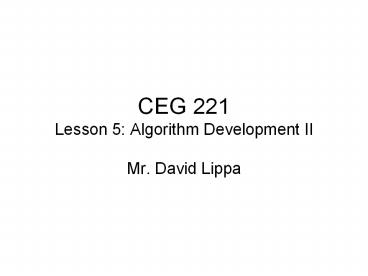CEG 221 Lesson 5: Algorithm Development II - PowerPoint PPT Presentation
Title:
CEG 221 Lesson 5: Algorithm Development II
Description:
Computing the remaining angles and side in an SAS Triangle ... f(0.25) f(0.5) f(0.5) f(0.75) f(0.75) f(1.0) ). Then, AREA = 0.5 * SUM. ... – PowerPoint PPT presentation
Number of Views:31
Avg rating:3.0/5.0
Title: CEG 221 Lesson 5: Algorithm Development II
1
CEG 221Lesson 5 Algorithm Development II
- Mr. David Lippa
2
Overview
- Algorithm Development II
- Review of basic algorithm development
- Advanced algorithm development
- Optimization of algorithm
- Optimization of code
- Questions
3
What is an Algorithm?
- An algorithm is a high-level set of clear,
step-by-step actions taken in order to solve a
problem, frequently expressed in English or
pseudo code. - Examples of Algorithms
- Computing the remaining angles and side in an SAS
Triangle - Computing an integral using rectangle
approximation method (RAM) or the Trapezoidal Rule
4
Example Triangulation with SAS
- If we return to the SAS triangle, theres nothing
really much to be done to improve speed or
efficiency, as the computation is very
straightforward.
5
Example Trapezoidal Rule
- You notice that we compute f(x) more times than
is necessary for all the inner values - Lets compute SUM2 2 ( f(0) f(0.25)
f(0.5) f(0.75) f(1.0) ) f(0) f(1.0). - AREA2 0.5 SUM2
- 4 trapezoids ? 8 computations of f
- 8 trapezoids ? 12 computations of f
- 1024 trapezoids ? 1028 computations
If the interval here is 0, 1, then we need to
compute SUM ( f(0) f(0.25) f(0.25)
f(0.5) f(0.5) f(0.75) f(0.75) f(1.0) ).
Then, AREA 0.5 SUM. 4 trapezoids ? 9
computations of f 8 trapezoids ? 15 computations
of f 1024 trapezoids ? 2047 computations Notice
a pattern?
6
Trapezoidal Rule Improvements
- For a small number of trapezoids, this method is
slightly more work. - For, say 1024 trapezoids, this is significantly
more efficient in terms of number of mathematical
calculations. - CONCLUSION Given that greater accuracy comes
with more trapezoids, this optimization is
sufficient, since this algorithm will rarely be
used with few trapezoids.
7
Optimizing Implemented Code
- There are other ways to speed up code
- Sacrifice memory for improved speed (ie. Always
try to work from memory, not from disk) - Avoid algorithms where the ratio of work required
to number of elements processed is n, namely an
n2 algorithm. - Pass by reference or pointer where appropriate to
prevent unnecessary memory copies of large
structures - Use algorithm analysis to try to find the cause
of the lack of speed
8
Algorithm Analysis
- Big-Oh notation how much work is required to
process n inputs in terms of n - Constants are less important for Big-Oh notation
- O(1), O(log2 n), O(n), O(n log2 n), O(n2), O(n3),
O(2n), O(n!) - Associate algorithms with each
- Matrix, Integration, SAS, factorial
- Formal definition
9
Using Algorithm Analysis
- Analyze an algorithm by computing the number of
operations performed per unit input - Avoid O(n2) or worse algorithms
- Convert code to pseudo code if needed, to do a
theoretical analysis
10
Algorithm Analysis Example
- Matrix Multiplication
- Pseudo code To multiply an m x n matrix A and
an n x p matrix B, dot product each row of A
with each column of B. - Results in m p dot products (see previous notes
for pseudo code details) - Dot product
- Pseudo code to dot product two vectors,
multiply the first element of each, the second,
the third, and so on and add them all together - Results in n multiplication and addition
operations (see previous notes for pseudo code
details) - RESULT Matrix multiplication is an O(m n p)
operation. With square matrices, it is O(n3)
11
Next Time
- Building Libraries
- Using Libraries
- Tradeoffs
- Questions
12
Questions?































